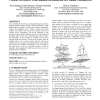22 search results - page 4 / 5 » Inductive Characteristics of Power Distribution Grids in Hig... |
INTEGRATION
2007
13 years 5 months ago
2007
The optimum wire shape to produce the minimum signal propagation delay across an RLC line is shown to exhibit a general exponential form. The line inductance makes exponential tap...
HPCA
2005
IEEE
13 years 11 months ago
2005
IEEE
As microprocessors become increasingly interconnected, the power consumed by the interconnection network can no longer be ignored. Moreover, with demand for link bandwidth increas...
JSA
2006
13 years 5 months ago
2006
Stringent memory access and search speed requirements are two of the main bottlenecks in wire speed processing. Most viable search engines are implemented in content addressable m...
DELTA
2006
IEEE
13 years 11 months ago
2006
IEEE
In high speed digital circuits, the inductive effect is more dominant compared to capacitive effect. In particular, as the technology is shrinking, the spacing between interconnec...
GLVLSI
2009
IEEE
14 years 10 days ago
2009
IEEE
Clock distribution networks are an important design issue that is highly dependent on delay variations and load imbalances, while requiring power efficiency. Existing mesh solutio...

